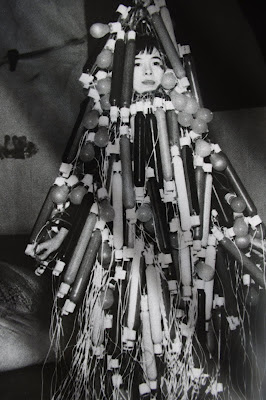Postwar Japan was a place of precipitous urban growth. The most
essential problem that emerged was how to distribute or enlarge
territory for human settlements, which number increased from 3.5 million
people in 1945 to 9.5 million in 1960. This is when Kenzo Tange propose
his Plan for Tokyo, and when young architects coming from his lab at Tokyo University, who later transform into Metablists think of projects such as Marine City or City in the Air.
 |
| Kenzo Tange presents Plan for Tokyo on TV in 1960 |
By the turn of the decade traditional mediums such as paintings, drawing and print were replaced by new tendencies and new generation of artists who emerged during Yomiuri Independent Exhibition (Yomiuri Anpan for short) - named after the newspaper company that sponsored it - held annually in Tokyo Metropolitan Art Museum from 1949 through 1963 and was admirably democratic in format.
The 10th edition of Anpan in 1958 featured core members of new generation - incuding Akasegawa Genpei, Arakawa Shusaku, Shinohara Ushio, Yoshimura Masunobu, Miki Tomio and Kudo Tetsumi. Many of these artist would be associated with the groups such as Neo-Dada and Hi Red Center, and were part of a larger tendency known as Anti-Art. Though they had few stylistic or formal commonalities, the works by these artist incorporated everyday objects, which soon became their signature feature and gained them the "junk anti-art" name.
The 10th edition of Anpan in 1958 featured core members of new generation - incuding Akasegawa Genpei, Arakawa Shusaku, Shinohara Ushio, Yoshimura Masunobu, Miki Tomio and Kudo Tetsumi. Many of these artist would be associated with the groups such as Neo-Dada and Hi Red Center, and were part of a larger tendency known as Anti-Art. Though they had few stylistic or formal commonalities, the works by these artist incorporated everyday objects, which soon became their signature feature and gained them the "junk anti-art" name.
 |
| Akasegawa Genpei, Sheets of Vagina (Second Present) 1961, vacuum tube, car tire inner tube, hubcap, and wood, courtesy MoMA |
 |
| Ushio Shinohara, Coca Cola Plan, 1964, paint, glass, plaster, metal fittings, wood, courtesy MoMA |
 | |||
Nakanishi Natsuyuki, Clothespins Assert Churinig Action,
courtesy MoMA 1963, clothing and clothepins on canvas, |
The 1960s opened with massive demonstrations against the renewal of United States-Japan Security Treaty known as ANPO. The highly controversial pack reinforced Japan's unequal partnership with its former enemy and prolong the stationing of US forces on the archipelago. In the following years, Japan had its share of student uprisings and anti-Vietnam War rallies. The street of Tokyo during this time were not only a site for political protests. Artists also made use of the city's public space as their own forum for radical actions and events.
In 1960s. art was distinctly anti-institutional. Ati-Art (Han-geijutsu) made concentrated effort to critique, subvert, and dismantle the art system, which echoed the politically turbulent atmosphere. Their anti-institutional radicalism went as far as to contribiting to the demise of the only stage for their works at the time - Yomiuri Anpan. In the aftermath of the Yomiuri Anpan's termination, avant-garde seek out alternative sites of operation. An urge for action inspired artists to wander into the streets as well as unconventional indoor venues, such as public bath.
 |
Zero Jigen,
Bathing Ritual in Full Dress, 1964 |
No one anticipated the visit of American triumvirate Cage-Cunningham-Rauschenberg with more eagerness than Shinohara Ushio, former member of Neo-Dada group. Known throughout art scene for his signature Mohawk haircut and declaration that imitating the works of other artists (in his case mostly American including Rauschenberg himself) was far more interesting, and even revolutionary than creating original works.
Although the Sogetsu Art Center existed until 1972, its character changed significantly after 1964.
 |
| Akasegawa Genpei, 1.000- Yen-Note Trial, 1963 |
The example made out of Akasegawa speaks to the metamorphosis of Japan and Japanese state during this period.
Adapted from Tokyo 1955-1970: A New Avant-Garde exhibition catalogue.




























